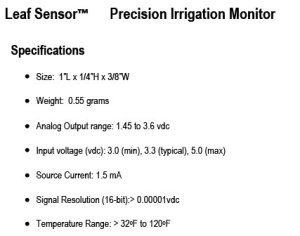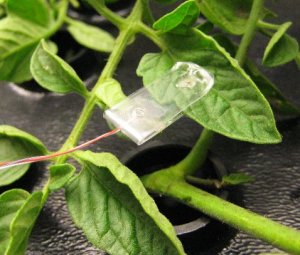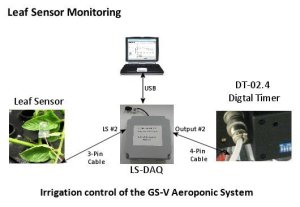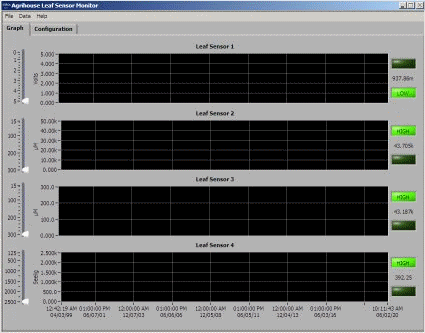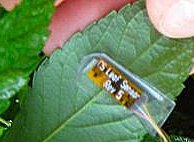The Rev 3 Leaf Sensor December 29, 2014
Posted by aeroponicsman in Agronomy, Arduino open source, bio-feed back, Consultants, Educators, Leaf Sensor, leaves, plants, Researchers.Tags: Digital Meter, leaf sensor
add a comment
The Rev 3 leaf sensor is now available. It has new improved electronics and clip. The clip is yellow making it easily visible to the naked eye. The lightweight device (0.55 g) measures 1.0″ L x 0.25″ W x 0.45″ H. Obtain real-time readings with a multimeter or data logger including Arduino devices and open source code.
AgriHouse has also released a Digital Meter to accompany the leaf sensor for an easy display of a leaf’s moisture level (turgidity). Turgidity or leaf thickness is measured in dc volts. The meters display resolution is 0.001 vdc (1 mv). AgriHouse’s OEM digital meter powers the sensor so you don’t need an external battery.
How to measure:
Take a reading before attaching the sensor to a leaf. Next affix the sensor to the leaf. This reading is your turgidity voltage reading.
Watering lowers the voltage reading. When the voltage goes up its time to water. The sensor is self-calibration upon removal from the leaf.
Open Source:
The Rev 3 leaf sensor can be used with an Arduino Uno (10-bit resolution). Connections are shown here (right). Use a Arduino Due and get 12-bit resolution.
Plug the Arduino into your USB and read the real-time data on your PC.
To obtain a copy of the Arduino source code click sketch_leafsensor.txt
For more info visit LeafSensor.com
Leaf Sensors for true aeroponic growing September 24, 2010
Posted by aeroponicsman in aeroponics, bio-feed back, Leaf Sensor, leaves, plants, Uncategorized.Tags: aeroponic, AgriHouse, closed-loop, data logging, digital, growing, leaf, Leaf Sensors, plants, pumps, software, solenoids, spray, timers, water
add a comment
AgriHouse’s leaf sensor technology product family just got larger – especially for aeroponic growing.
There’s no better closed-loop growing technology than true aeroponics growing (TAG). Why? Because the minimal water required per spray duration. For instance the GS-V aeroponic system will deliver approximately 200 ml (or 6.6 oz) water/nutrients per 161 mature plants in 8 sq ft.
The spray delivery rate is 200 ml spray every 3 minutes, most of which returns to the system’s reservoir. Leaving the entire plant growing in air until the next spray. That’s only 1.2 ml of water/nutrient solution per plant.
What else can grow a plant with 1.2 ml of water per spray?
A true aeroponic plant will spend over 89% of its time in growing in air. But just when you thought that 200 ml of water per spray every 3 minutes was a low amount of water to sustain aeroponic plant growth. It’s time to think less.
Affixing a leaf sensor to an aeroponic system can conserve 20% or more water to grow a plant. Besides using less water this means less energy and nutrients to run the system. Another cost savings benefit is reduced wear & tear on the pumps and solenoids. Plus the plants determine their own watering needs for healthier growth.
1. Install AgriHouse’s leaf sensor monitoring software on a PC running WinXP or Win2000.
2. Connect the leaf sensor to AgriHouse’s new LS-DAQ Interface device.
3. Connect the interface to the PC’s USB port.
4. Connect AgriHouse’s new DT-02LS digital timer & solenoid to the interface and set the timer’s DIP#4 to ON.
The Leaf Sensor Beta Monitoring Software knows when the leaf sensor is affixed to the plant and then determines the water needs of the plant. This based upon the bio-feedback of leaf turgidity. The interface activates the watering/spray via DT-o2LS’s internal solenoid. Only when the plant determines its watering needs (via the software) will water be sprayed for 3 seconds into the aeroponic chamber.
The DT-02LS has a default timer mode in case the LS-DAQ Interface becomes disconnected or the PC is turned off. The default timer mode is the standard 3 second spray every 3 minutes as mentioned above.
AgriHouse’s new Leaf Sensor Beta Monitoring Software v2.2 includes calibration features, data logging, settable averaging period, real-time waveform display in micrometers, affixed and watering notification for up to four leaf sensors, master enable control of individual outputs. There are four configurable leaf sensor channels, each with individual outputs.
The LS-DAQ Interface can connect up to four leaf sensors and control up to four separate Genesis Series V Aeroponic Systems and/or aeroponic chambers.
Yes it’s true. Affixing a leaf sensor to an aeroponic system can conserve 20% or more water and increase plant growth.
The NSF (National Science Foundation) has a new video on the leaf sensor subject. This video briefly covers the subject of the leaf sensor technology operating the GS-V aeroponic system.
Copyright AgriHouse Inc 2010
Leaf Sensor Exclusive License from CU January 12, 2010
Posted by aeroponicsman in bio-feed back, Leaf Sensor, leaves, plants, University of Colorado TTO.Tags: biometric feedback, CU, farm, irrigation, Leaf Sensors, water conservation
1 comment so far
CU-developed leaf sensor saves water by telling growers when to irrigate.
Boulder (January 11, 2010). Agri-biotech company AgriHouse, Inc. recently executed an exclusive license with the University of Colorado for intelligent leaf sensor technology enabling more precise control of water use in farming and greenhouses.
 AgriHouse, headquartered in Berthoud, Colo., is developing leaf sensors to measure and monitor plant moisture demands and other plant physiological sensing applications. The company’s first product, the SG-1000 Leaf Sensor and Precision Irrigation Control Software, became commercially available in the 4th quarter of 2009. The SG-1000 Leaf Sensor is being used by researchers working in plant growth, as well as in commercial greenhouses; in addition to saving water and preventing loss of plants, the leaf sensor allows for direct measurement of plant hydration, replacing current monitoring technologies that direct watering indirectly from indicators such as soil moisture and air temperature.
AgriHouse, headquartered in Berthoud, Colo., is developing leaf sensors to measure and monitor plant moisture demands and other plant physiological sensing applications. The company’s first product, the SG-1000 Leaf Sensor and Precision Irrigation Control Software, became commercially available in the 4th quarter of 2009. The SG-1000 Leaf Sensor is being used by researchers working in plant growth, as well as in commercial greenhouses; in addition to saving water and preventing loss of plants, the leaf sensor allows for direct measurement of plant hydration, replacing current monitoring technologies that direct watering indirectly from indicators such as soil moisture and air temperature.
In a 2008 test at a U.S. Department of Agriculture (USDA) research farm near Greeley, the company’s leaf sensor demonstrated an approximate 25% water savings over conventional watering schedules. (Colorado farmers currently spend more than $100 million annually for water and energy to irrigate their crops.)
Data monitoring captured by the leaf sensor and software also measures plant responses to evaporation, temperature and humidity fluctuations, along with wind gusts, soil moisture levels and natural rainfall. The sensors work in real time, and are functional during the entire growing season for any type of crop. “Because of its low-profile and non-intrusive features, the sensor can benefit researchers needing to better understand water flow mechanics, nutrient uptake and yield performance,” says Richard Stoner, founder and president of AgriHouse. “The SG-1000 Leaf Sensor is another tool in the farmer’s toolbox for controlling and lowering the cost of on the farm inputs. It is simply smart sense for water management and water & energy conservation.”
The sensors work by combining magnetic resistance and radio frequency to enable on-demand watering, providing a localized alternative to current technologies of soil-based moisture monitoring and aerial infrared imaging. The technology was developed in the University of Colorado Department of Aerospace Engineering, and was the subject of a $150,000 Small Business Technology Transfer grant from the National Science Foundation (NSF) in 2008. The first patent covering the technology was granted in the 4th quarter of 2009.
“AgriHouse has been extremely efficient in converting this technology from lab demonstration to pilot production,” said Ted Weverka, a licensing manager at the University of Colorado Technology Transfer Office. “They get the technology in front of the customer, get feedback and launch product without delay.”
AgriHouse is currently beta-testing wireless versions of the sensor, which would enable use in home gardeners, greenhouses, farmers and other large-scale operations. Both the current version and the wireless leaf sensor interface seamlessly into precision irrigation control software developed by AgriHouse
About AgriHouse:
AgriHouse is a leading edge agri-biotechnology company offering advance high performance food production systems for earth and space. AgriHouse was found in 1992 by Richard Stoner and Dr. Ken Knutson, Plant Pathologist, Colorado State University. The company has a broad portfolio of IP and patents to deliver cost effective green technologies to increase food production, conserve water and natural resources, reduce the reliance on toxic pesticides, and allow plants to regulate their own environmental needs through intelligent bio-feed systems.
In 2009 AgriHouse released its ODC™ Colloidal Chitosan for beetle kill protection. The USDA Forest Service tested ODC in 2008, on pine trees. ODC significantly increased (40%) pine resin pitch-out revealing a potential reduction (37%) in beetle eggs in pine trees. ODC was first sponsored by BioServe Space Technologies, NASA-sponsored Research Partnership Center, aboard the space shuttle. BioServe is located on the campus of the University of Colorado, Boulder, CO. For additional information visit www.agrihouse.com and www.leafsensor.com.
Photo: SG-1000 Leaf Sensor Photo © 2009, AgriHouse, Inc.
Other news sources:
University of Colorado Technology Transfer Office Blog: http://cutechtransfer.blogspot.com/2010/01/agrihouse-inc-completes-exclusive.html
Northern Colorado Business Report January 12th, 2009 AgriHouse awarded exclusive licensing for leaf sensor technology
Review of the Leaf Sensor Bio-feedback System November 2, 2009
Posted by aeroponicsman in bio-feed back, Leaf Sensor, leaves, plants.Tags: Leaf Sensor Bio-feedback irrigation controller software water conservation biofeedback NSF DAQ
1 comment so far
AgriHouse updated its line of the SG-1000 Leaf Sensor Bio-feedback System. It now includes a stand-alone leaf sensor, micro-disk calibration standards set, analog to digital module, and software for analysis and control of irrigation systems.

SG-1000 Leaf Sensor connected to a standard digital multimeter (shown w/ Calibration Std)
AgriHouse’s SG-1000 Leaf Sensor is available as stand-alone device. It comes with its own calibration standard as well. The SG-1000 Leaf Sensor can be connected to any common digital multimeter. The multimeter will give the user an instant reading of a plant’s moisture level. It works in real-time from the multimeter as power source with the read-out in volts (shown here). You will need a multimeter with NPN/PNP testing capability to utilize its 3 volt power source (or connect it to a battery).
AgriHouse also combined all of the components into a single product package which includes four leaf sensors. These same components were used by the USDA in a demonstration field study under AgriHouse’s National Science Foundation (NSF) grant.
AgriHouse’s SG-1000 Leaf Sensor Analysis and Control Software has four individual graphs for instant read-outs of a leaf’s moisture level. The moisture level is an indirect reading of the leaf turgidity (turgor pressure) or simply put – leaf thickness. The user can select when and how the moisture data is updated into the graphs. AgriHouse devised the software to provide the user with the option to read the leaf moisture in volts, micromenters and something it calls Seeligs. The graphs automatically scroll based upon the user settable averaging period.
The Leaf Sensor software interface uses the standard National Instruments (NI) Labview screens. Fortunately the user doesn’t have to purchase NI’s expensive professional Labview software – instead AgriHouse packages all the drivers and executable Labview software on a DVD. The software runs in WinXP and Window 2000.
Moisture data can be stored in a data file that the user creates. The data can later viewed using Microsoft Excel. Data charts and graphs can be created right in Excel spreadsheets by the user. There is also a simulation mode available in the software.
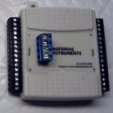
SG-1000 Leaf Sensor DAQ Module
AgriHouse utilizes a DAQ ( data acquistion) OEM Module from NI. As with the a digital multimeter the user connects the ground, power and signal wires directly into the DAQ. The DAQ connects to a PC by means of a USB cable. The DAQ converts leaf sensor analog signal into a digital out. The device has four individual leaf sensor inputs, each capable of turning ON and OFF two separate digital output lines. That’s eight individual digital output ports the user can use to attach their solenoids, switches and pumps to the module. The outputs have an enable/disable mode based upon upper and lower limits mode with settable hysteresis for each leaf sensor input.
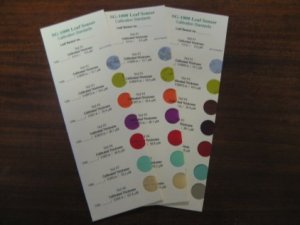
SG-1000 Leaf Sensor Calibration Standards
AgriHouse also offers a calibration standard set. It comes on a single card with seven precision micro-thin disks for calibrating each leaf sensor. The seven micro-thin disks each have a tolerance of + 0.00001 inches. These can used as calibration standards for thin and thick plant leaves. The card contains areas for entering a leaf sensor number and the voltage for each micro thin disk.
The user can choose to purchase AgriHouse’s stand-alone SG-1000 Leaf Sensor with a digital multimeter (and upgrade after some hands-on experience with measuring a plant’s leaf moisture level) or purchase the entire leaf sensor software package for immediate precision irrigation control.
For the complete line of SG-1000 Leaf Sensor Bio-feedback components and hardware visit www.leafsensor.com
AgriHouse releases the SG-1000 Leaf Sensor June 15, 2009
Posted by aeroponicsman in Leaf Sensor.Tags: AgriHouse SG-1000 Leaf Sensor Precision Irrigation Control Water National Science Foundation NSF
3 comments
It’s here – the new Leaf Sensor that tells humans – “I’m Thirsty!”
This exclusive smart sensor technology includes leaf sensors, trending software, data acquisition module, and a USB cable.
SG-1000 Leaf Sensor and Trending Software Features:
* Real-time leaf turgidity reading
* USB interface (PC)
* Software: Proprietary Executable code
* Non-intrusive & non-damaging to plants
* 24/7 operation
* Activate watering systems
* Water resistant design
The SG-1000 Leaf Sensor and Trending Software was funded and developed by AgriHouse under a National Science Foundation (NSF) research grant to help monitor, control and conserve water. This green technology (smart sensor) leaf sensor has been featured on TV and radio worldwide.
For more information visit Leaf-Sensor
